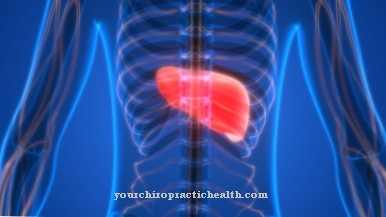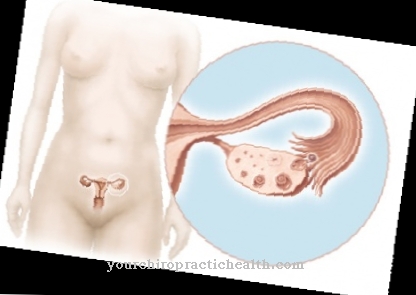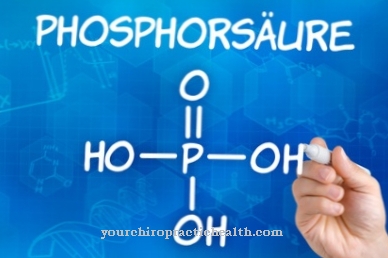About the Vasodilation and the vascular obstruction controls the autonomic nervous system, i.e. the sympathetic and parasympathetic nervous system, and many body functions such as blood pressure, cardiac output and thermoregulation. Basically, vessel widening, which is achieved by relaxing the smooth muscles in the walls of the blood vessels, increases the volume of blood in the vessels and reduces blood pressure.
What is vessel dilatation?

As a vasodilator, too Vasodilation called, is understood to mean an increase in the volume of the blood vessels, which is achieved by relaxing the smooth muscle tissue in the walls of the veins.
The system of tension and relaxation is controlled vegetatively by the sympathetic and parasympathetic nerves. As a rule, the stress hormones produced by the sympathetic nervous system lead to blood vessel constriction and an increase in blood pressure. The parasympathetic nervous system, as the antagonist of the sympathetic nervous system, partially reduces the stress hormones and synthesizes hormones and neurotransmitters, which in principle lead to vasodilation.
Vascular dilatation does not take place in all of the body's vein systems at the same time; rather, in the event of psychological stress, the sympathetic system ensures that the vessels supplying the skeletal muscles are widened and the peripheral vessels and those of the kidneys are narrowed.
Vascular dilatation also plays a major role in thermoregulation to avoid excessive body temperature. The most important physiological mechanism is a reduced influx of calcium into the smooth muscle cells of the vessel walls. This causes the muscle cells to relax, resulting in an increase in volume and a widening of the vessels.
In special cases, e.g. B. in the case of severe blood loss, the body uses the vessel widening with simultaneous vasoconstriction of the peripheral vessels as an emergency program in order to be able to supply the most important organs with the remaining blood.
Function & task
The vegetatively controlled vessel dilatation and its counterpart, the vessel constriction, primarily serve to stabilize the circulation in the case of different and changing requirements. The autonomic nervous system controls circulatory functions such as blood pressure and cardiac output via the vessel dilatation. It is of great importance that the vasodilation does not take place in an undifferentiated manner across the entire vascular system, but that sympathetic stress hormones such as adrenaline and noradrenaline cause the vessels in the muscles and some organs to widen, but at the same time cause the peripheral vessels to constrict. In the short term, this ensures that the muscles achieve maximum performance because they are better supplied with blood through the dilatation of the vessels. The simultaneous vasoconstriction of the peripheral blood vessels reduces the risk of bleeding in the event of injuries, and the temporarily reduced blood supply to the kidney vessels results in reduced urine production.
In stressful situations, vessel widening is part of the reactions that optimally prepare the body for flight or attack. Physiologically, the body reacts to traumatic conditions such as severe injuries and high blood loss by releasing stress hormones. The widening of the blood vessels concentrates the remaining blood in the body, and the narrowing of the peripheral vessels reduces further blood loss in the event of an external injury.
Vascular dilatation also plays a major role in thermoregulation. When the body's thermal receptors report that the body temperature has risen above the target value of around 37 degrees Celsius, the parasympathetic nervous system ensures that the peripheral blood vessels expand. This means that more blood circulates in the peripheral vessels, so that the cooling effect is intensified by the outside air passing by. The vasodilatation is then visible to the outside, especially in the face as a result of reddening.
The increased cooling effect also works in combination with perspiration to use the evaporative cooling at high outside temperatures and / or during vigorous physical activity, which releases excess heat in the muscles.
To a certain extent, the vessel dilatation can also be used for communication in body language. In the case of psychological excitement, especially in anger and states of aggression, the face, neck and décolleté mainly become red. The red skin color, which is due to a short-term increase in blood pressure and vasodilatation, signals the current state and generally advises caution.
Illnesses & ailments
Vascular dilatation is of great importance for the control of many homeostatic physiological processes in open dynamic systems. Especially when adapting circulatory parameters such as blood pressure, heart rate and the heart's capacity to the respective needs.
Functional restrictions in vasodilation can trigger acute and chronic problems. The most well-known disruptive factor that can impair the physiological mechanism is arteriosclerosis. Deposits (plaques) in the vessel walls of arteries make them inelastic and, as the disease progresses, the cross section becomes narrower. A relaxation of the smooth muscle cells in the vessel walls caused by parasympathetic neurotransmitters is then no longer fully effective. The blood pressure can no longer adapt sufficiently to the requirements. This is particularly noticeable in the diastolic blood pressure (relaxation phase), which should only increase minimally when the body is exposed to a slight permanent load. In the case of arteriosclerotic changes in the vessels, the diastolic value increases significantly with continuous stress.
Vascular dilatation must always be seen in connection with vascular constriction. The interplay between the sympathetically controlled tension and the parasympathetically controlled relaxation is of great importance. If the interplay is disrupted, what is known as vegetative dystonia is often diagnosed. However, this term is not used by all doctors because the disease cannot be precisely defined and a diagnosis of embarrassment is suspected.
With regard to the widening of the vessels, the disturbed interplay can lead to a constantly increased sympathetic tone with an increased stress hormone level whitewashing the parasympathetic relaxation stimuli, so that there is no vessel widening to generally lower blood pressure. This leads to chronic high blood pressure (hypertension), which, if left untreated, can lead to serious secondary problems.













.jpg)

.jpg)
.jpg)











.jpg)